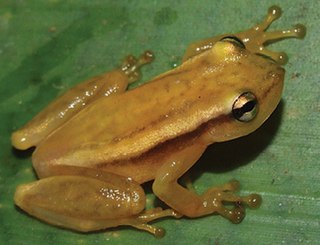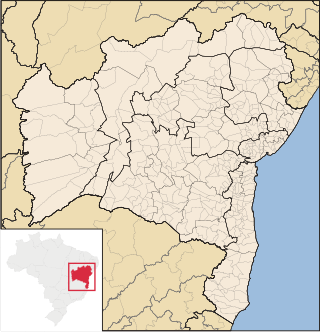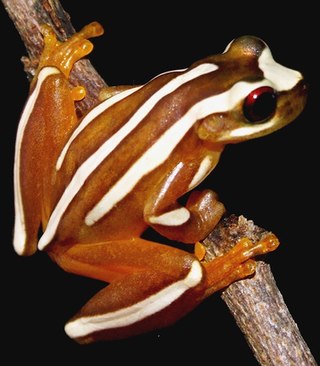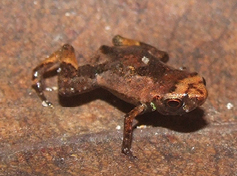
Jorge Amado was a Brazilian writer of the modernist school. He remains the best-known of modern Brazilian writers, with his work having been translated into some 49 languages and popularized in film, including Dona Flor and Her Two Husbands in 1976. His work reflects the image of a Mestiço Brazil and is marked by religious syncretism. He depicted a cheerful and optimistic country that was beset, at the same time, with deep social and economic differences.

Phyllodytes is a genus of frogs in the family Hylidae. It is endemic to eastern Brazil.

Nyctimantis is a genus of frogs in the family Hylidae. The genus is found in south-eastern Brazil as well as in the Orinoco Basin in Venezuela, Colombia, and Brazil. These are tree-dwelling species usually hiding in the cisterns of epiphytic bromeliads. The top of the head carries a bony plate which is fused with the skin.

Adelophryne is a genus of frogs in the family Eleutherodactylidae. They are native to northern South America east of the Andes, known roughly from the area corresponding to the Guiana Shield, as well as to the coastal area of Bahia, Brazil. Whether the genus is truly distinct from Phyzelaphryne remains uncertain. Common name shield frogs has been proposed for this genus, although the stem flea frog is used for some species.

Dendropsophus branneri is a small hylid tree frog endemic to the Atlantic Forest region of Brazil. It feeds mainly on arthropods and is preyed upon by various invertebrates and vertebrates. Although currently classified by the IUCN Redlist as "least concern", D. branneri suffers rapid habitat loss due to residential development, agriculture, logging, and clearing for pastureland. Male D. branneri are noted for their fighting call, which differs significantly in frequency, duration, and pulses per call compared to their mate advertisement call. Males are also noted for their willingness to escalate physical altercations against other males, which includes kicking, pushing, and wrestling their opponent into non-dominant positions. Unlike most other frog species, D. branneri can breed in both temporary and permanent pools allowing it to inhabit a wide variety of habitats leading to its wide distribution.
Boana latistriata is a species of frog in the family Hylidae. It is endemic to Brazil and only known from its type locality, Itatiaia National Park, and from Marmelópolis, both in the state of Minas Gerais. The specific name latistriata refers to the wide stripes on the back of this frog.
The Alagoas heart-tongued frog is a species of frog in the family Hylidae, the tree frogs and allies. It is endemic to Brazil, where it is known from coastal regions in Bahia, Alagoas, and Pernambuco. It has been observed as high as 550 meters above sea level.
The Alhandra heart-tongued frog is a species of frog in the family Hylidae endemic to Brazil. It has been observed as high as 100 meters above sea level.

The Brazilian heart-tongued frog is a species of frog in the family Hylidae endemic to Brazil's Atlantic forests. It has been observed as high as 600 meters above sea level.

The Bahia heart-tongued frog is a species of frog in the family Hylidae endemic to Brazil's rainforests. It has been observed as high as 800 meters above sea level.
Phyllodytes punctatus is a species of frogs in the family Hylidae endemic to Brazil. People have seen it as high as 140 meters above sea level.

Phyllodytes wuchereri is a species of frog in the family Hylidae endemic to Brazil in the Atlantic forest in the state of Bahia. This frog has been observed 400 meters above sea level.

Proceratophrys schirchi is a species of frog in the family Odontophrynidae. It is endemic to eastern Brazil and occurs in southeastern Bahia, Espírito Santo, northeastern Minas Gerais, and Rio de Janeiro states. The specific name schirchi honours Paulo F. Schirch, a Brazilian zoologist who collected the type series. Common names Santo smooth horned frog and Brazilian smooth horned frog can refer to this species, the latter specifically referring to Proceratophrys precrenulata that is now considered a junior synonym only.

Phasmahyla spectabilis is a species of frog in the subfamily Phyllomedusinae. It is endemic to Brazil and known from the north-eastern Minas Gerais and adjacent southern Bahia. It occurs in fragments of Atlantic Forest at elevations of about 800 m (2,600 ft) above sea level.People have seen it as high as 850 meters above sea level.

Phyllodytes maculosus is a species of frogs in the family Hylidae endemic to Brazil's rainforests. It has been observed between 77 and 837 meters above sea level.

Nyctimantis arapapa, also known as Bahia's broad-snout casque-headed tree frog, is a species of frog endemic to the Atlantic Rainforest of southern Bahia, Brazil. The frogs of the genus Nyctimantis are distinguished by a bony plate on top of their heads, referred to as "casque-headed". Casque-headed frogs are characterized by their phragmotic behavior. N. arapapa is further characterized by the long bill-shaped "snout" they possess, similar to that of Triprion petasatus, a head longer than it is wide, and their small size. This species, and all species of Nyctimantis, use their unique head shape to seal off the leaves of bromeliads, the plant they inhabit solely. This has two known purposes: warding off predators from the frog as well as their young, and trapping moisture.

Dendropsophus nekronastes is a frog in the family Hylidae. It is endemic to South America. Scientists know it solely from its type locality in Bahia, Brazil, 303 meters above sea level.
Phyllodytes megatympanum is a frog in the family Hylidae endemic to Brazil. It has been observed between 90 and 95 meters above sea level.

Phyllodytes praeceptor is a species of frog in the family Hylidae endemic to coastal areas in the state of Bahia in Brazil. It has also been seen in Serra da Jiboia, 694 m above sea level.

Brachycephalus pulex, also known as the Brazilian flea toad and the Serra Bonita flea toad, is a species of small frogs in the family Brachycephalidae. It is one of more than 35 named species within the genus Brachycephalus. It has been suggested to represent the smallest known vertebrate, with an average snout–vent length of 7.10 millimetres (0.280 in) in mature males.














